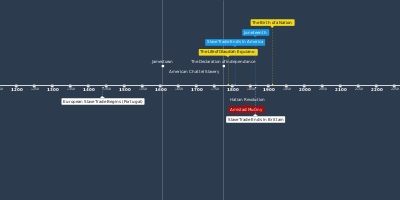jul 2, 1839 - Amistad Mutiny
Description:
On June 27, 1839, La Amistad ("Friendship"), a Spanish vessel, departed from the port of Havana, Cuba (then a Spanish colony), for the Province of Puerto Principe, also in Cuba. The masters of La Amistad were the ship's captain Ramón Ferrer, José Ruiz, and Pedro Montez, all Spanish nationals. With Ferrer was Antonio, a man enslaved by Ferrer to serve him personally. Ruiz was transporting 49 Africans, entrusted to him by the governor-general of Cuba. Montez held four additional Africans, also entrusted to him by the governor-general. On July 2, 1839, one of the Africans, Cinqué, freed himself and the other captives using a file that had been found and kept by a woman who, like them, had been on the Tecora (the Portuguese ship that had transported them illegally as slaves from West Africa to Cuba).The Mende killed the ship's cook, Celestino, who had told them that they were to be killed and eaten by their captors. The Mende also killed Captain Ferrer; the armed struggle resulted as well in the deaths of two Africans. Two sailors escaped in a lifeboat. The Mende spared the lives of the two Spaniards who could navigate the ship, José Ruiz and Pedro Montez, upon the condition that they would return the ship east back across the Atlantic Ocean to Africa. They also spared Antonio, a creole, and used him as an interpreter with Ruiz and Montez.
The crew deceived the Africans and steered La Amistad north along the East Coast of the United States, where the ship was sighted repeatedly. They dropped anchor half a mile off eastern Long Island, New York, on August 26, 1839, at Culloden Point. Some of the Africans went ashore to procure water and provisions from the hamlet of Montauk. The vessel was discovered by the United States Revenue Cutter Service ship USS Washington. Lieutenant Thomas R. Gedney, commanding the USRCS cutter (ship), saw some of the Africans onshore and, assisted by his officers and crew, took custody of La Amistad and the Africans.
Taking them to the Long Island Sound port of New London, Connecticut, he presented officials with a written claim for his property rights under international admiralty law for salvage of the vessel, the cargo, and the Africans. Gedney allegedly chose to land in Connecticut because slavery was still technically legal there, under the state's gradual abolition law, unlike in nearby New York State. He hoped to profit from the sale of the Africans. Gedney transferred the captured Africans into the custody of the United States District Court for the District of Connecticut, at which point legal proceedings began. [see United States v. The Amistad]
Added to timeline:
Date:
jul 2, 1839
Now
~ 186 years ago
